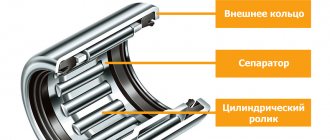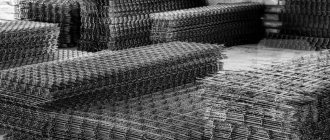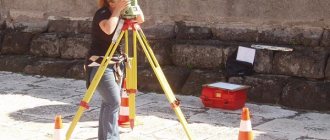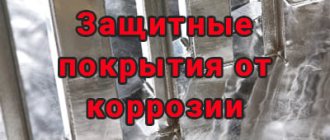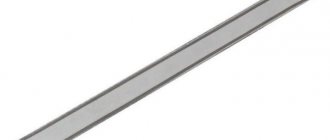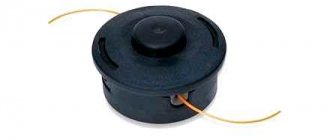Fencing around residential or industrial buildings allows you to delineate the boundaries of the site and protects the territory from entry by unauthorized persons. In addition to solid fences made of profile sheets, lattice structures are used that transmit light and have a low price. Before attaching the chain-link mesh to metal poles, you need to decide on the technology and mount the supports.
Mesh fence is used to fence residential and industrial buildings.
Properties and characteristics of mesh
The material was developed in the late 80s. XIX century German engineer Karl Rabitz. The inventor created and patented a machine that made it possible to quickly weave wire. In the 21st century the flexible fabric is made of drawn steel wire with a protective anti-corrosion coating (zinc or polymer based). The material has a circular cross-section, the lines intertwine with each other, forming diamond-shaped cells with a lower and upper angle of 60°.
Chain-link mesh is a flexible steel sheet with cells.
There are several dozen varieties of mesh, differing in the type of wire and the dimensions of the pattern. The most common sheets are made of material with a diameter of 1 to 6 mm, having a cell size in the range from 15 to 120 mm. Reducing the dimensions of the window increases strength, but at the same time the cost of production increases.
The mesh is supplied in the form of rolls in accordance with the GOST 5336-80 standard (for example, 3x10 m reels are more often used for fences).
Types of chain link
To attach the chain-link mesh to the profile pipe, you need to select the optimal type of mesh material. These products are classified as follows:
- without zinc coating;
- galvanized;
- with PVC coating.
Tension fastening method
In the manufacture of non-galvanized chain-link, wire made of black low-carbon steel without a protective coating, 1 or 5 mm thick, is used. The main disadvantage of such products is their high susceptibility to corrosion and, accordingly, a short service life of 2–3 years. This material is only suitable for installing temporary fencing.
Meshes with zinc and PVC coating have high anti-corrosion properties, therefore they are more in demand. Mesh material is available in various shapes and mesh sizes.
Fence post made of corrugated pipe
The strength of the product is determined by the size of the cells. The smaller they are, the stronger the mesh. The standard hole size of the mesh material used to construct the fence is 40–50 mm.
Advantages and disadvantages of a mesh fence
Positive aspects of the material:
- ease of erection of fencing;
- the low weight of the components allows you to abandon the need for pillar foundations;
- ensuring air flow and lighting the area along the fence;
- lack of windage, the presence of cells removes wind loads from the surface;
- suitability of chain-link for installation of decorative elements decorating the local area;
- the mesh does not require periodic cleaning and painting;
- the ability to install an additional protective line of barbed wire or Bruno spiral on top of the fence.
The mesh fence is not difficult to install and is resistant to wind loads.
Disadvantages of the material noted by builders and home owners:
- reduced mechanical strength of the fence;
- ease of destruction of the mesh by an attacker using wire cutters or metal scissors;
- lack of protection of the territory from prying eyes and strong winds;
- sagging of the canvas during operation;
- the tendency of mesh made of structural steel to corrosion under the influence of atmospheric moisture;
- short service life of the fence (when using chain-link with a galvanized surface, the canvas begins to deteriorate after 8-10 years);
- the cells do not protect the local area from small debris and dust;
- lack of aesthetics, since the mesh fence was originally created to fence off industrial facilities.
Obvious advantages
Non-galvanized mesh is made of ferrous metal. Its service life is about 3 years due to its high susceptibility to corrosion. This mesh can only be used as a temporary fence. If you plan to install a permanent fence, then it should be well painted and updated every 4-5 years.
Galvanized mesh is resistant to corrosion, which is why it is in great demand. Plasticized mesh is made of metal and coated with a special polymer that increases anti-corrosion resistance.
Types of designs
The mesh material is characterized by low rigidity and requires the installation of power elements for reliable fastening. The chain-link is pulled between the pillars, and additional jumpers are introduced between the supports. There is a technology for assembling a fence from ready-made sections of standard sizes. The owner of the site independently chooses the method, focusing on the budget and durability of the fence.
Installation of a mesh fence can be done in several ways.
Without guides
The technology involves installing vertical iron pillars from water pipes in increments of 2.5-3 m; the base is buried 80-100 cm into the soil. The mesh is stretched between the pillars and secured with staples. If the soil in the area is sandy, then rain and melt moisture freely goes into the lower layers. On clay soils, a gravel cushion is provided in the pits for supports; in the absence of a substrate, during the period of soil heaving, the fence warps, and cracks form under the lower edge of the chain-link.
When installing a mesh fence without guides, the chain-link is attached to the posts with staples.
With guides
The design is distinguished by the installation of 2 horizontal jumpers made of steel profiles or timber. For fastening, welding or bolts are used; a rigid joint leads to warping of the fence when the soil swells and the concrete base of the post is squeezed out of the hole. To prevent deformation, holes are dug to a depth below the freezing level (depending on the region). A gravel cushion is poured onto the bottom, and then the vertical element of the fence is filled with concrete mortar.
Mesh fence with horizontal guides.
Sectional
The structure consists of a steel frame in which the mesh is fixed. The sections are installed between vertical pipe elements, the upper part of the support is closed with a plug to protect against moisture and the occurrence of corrosion. The frames are fixed by electric arc welding or metal brackets with bolts. The product has a neat appearance, increased strength, the depth of the holes for the posts should be 20-30 cm below the soil freezing line.
Sections of a mesh fence are represented by separate frames in which a chain-link is fixed.
Final finishing - decoration, photo
A fence built with your own hands using chain-link mesh has a neat appearance, but nothing more. Over time, the desire arises to somehow decorate it. You don't have to be an artist or designer to do this. It is enough to show your imagination, and your fence will become a piece of art.
The easiest way to transform a fence is to plant climbing plants next to it. In a few months, your fence will turn into a flowering wall. The pillars can be decorated with clay pots, this will give the fence ethnic beauty.
Fence cells can be turned into canvas for embroidery. Just like drawing on a canvas, you can weave beautiful patterns with your own hands. For this you will need wire. If you use colored twine, then with its variety of colors and shades you can create three-dimensional images.
Recently, it has become popular to decorate the fence with a photo grid. The drawing can be absolutely anything. The peculiarity of this material is that from a distance a continuous pattern is visible, but in fact it consists of a fine polymer mesh, which is perfectly ventilated.
Wire resembling lace is an interesting option for those who have nothing to hide
Painted roses look elegant. The main thing is that the drawing on the photo grid matches the landscape
Wide grape leaves will decorate and hide the area from prying eyes
How and with what to close the fence from neighbors: options with photographs
Since a chain-link fence is completely transparent, any home owner will want to hide it from prying eyes. It is not advisable to cover it with any shields or boards.
The easiest way is to cover the fence with camouflage netting. Visibility through the fence will be much less, but the appearance will also be unattractive.
You can cover the fence with reed mats. This method is more expensive than the previous one. Attaching them is not difficult; you just need to unwind the roll and secure it in several places with wire.
A similar option is to use artificial pine needles. This material is sold in rolls. It is used in making wreaths and baskets, but it can also be used for fencing.
A fence that is covered with a camouflage net looks aesthetically pleasing only if you are in a paintball zone
Rolls of reeds are a more expensive option
The use of artificial needles looks original
How a mesh section is made
For manufacturing, it is necessary to weld a frame from a steel angle, corresponding in length to the pitch of the supports. A mesh is attached to the resulting frame on welded steel rods, passing the rods through the outer cells, ensuring uniform tension of the web. Instead of guides, you can use steel hooks. Then the frame surfaces are cleaned of scale and traces of corrosion, and then a protective paint coating is applied. The sections are assembled in an industrial environment; the home owner can independently manufacture the structures, taking into account the characteristics of the fence.
Selecting a mesh for metal poles
When selecting material you must:
- Explore the bays. The corners of the squares located at the bottom and top should be formed by intertwined pieces of wire with bent ends. The size of the bent part determines the ease of tension; it is recommended to take a chain-link with bends having a length of about 50% of the size of the cell edge.
- Make sure that the weaving is uniform and there is no deformation of the wire. Bends indicate low quality steel, which will begin to rot after 2-3 winters. If the surface of the wire is coated with a polymer composition, then the warranty period should be specified. Budget plastic is destroyed under the influence of ultraviolet light and temperature changes over 1-2 winters. When a high-quality coating is applied, a mesh fence will last from 15 to 30 years without corrosion.
- Assess the quality of galvanization. The presence of dark spots on the surface indicates cold technology. Zinc is applied in a thin layer with low strength.
Types of mesh fences
It is necessary to divide the mesh into two groups, differing from each other in the source material. These are metal mesh and plastic. The latter are rarely used for fencing areas because they do not have sufficient strength. They are used for fencing flower beds, garden plantings and other structures.
In this regard, metal fencing structures made of mesh are used everywhere. Because they have high technical and operational characteristics. Today, two types of mesh are used for fencing: chain-link and welded.
They differ from each other in manufacturing technology. The first is made by weaving with the formation of cells, the second by spot welding, in which metal rods are connected.
It cannot be said that welded mesh is better than chain-link. Both have fairly high strength characteristics and almost identical advantages and disadvantages.
Advantages and disadvantages of welded mesh
The main advantage of fences made of welded mesh is low price with high technical characteristics. Next we note:
- the ability to dismantle the mesh and use it in another place for the construction of fences or other needs;
- ease of installation;
- a huge variety of sizes offered, which makes it possible to build fences of different heights;
- easily tolerates natural stress;
- transparency of the structure, allowing air and sunlight to pass through, which is an important factor for some areas.
Regarding the shortcomings, many regard the last plus as a minus. Not everyone likes having their personal life wide open. And the transparent design contributes to this. The second negative is that the appearance is not entirely presentable when compared with other fencing structures, for example, brick, stone or wood.
Not the most presentable appearance
Varieties
The classification of welded mesh is based on the source material. There are three categories:
- Made from carbon steel without protective coatings. It is welded from metal rods with a diameter of 1.2-10 mm. Such products are susceptible to metal corrosion, so they become rusty over time. This type of metal mesh must be painted to reduce wear. Painting is carried out with enviable frequency, which increases the cost of maintaining the enclosing structure.
- Galvanized. It is welded from galvanized wire, which practically does not rust under the influence of natural loads. It has a fairly long service life; there is no need to paint such a product. Still, it's not the best material.
- Not galvanized with polymer coating. In fact, this is the first option that is coated with a polymer layer. The finished mesh is simply dipped into the polymer mass and then dried. To give the product a more presentable appearance, it is coated with paint using powder technology. This further increases the protective qualities.
- Galvanized with a polymer layer. This is the pinnacle of metal mesh quality, but also the pinnacle of price. Welded mesh of this type can be classified as materials in the category with an unlimited service life, although manufacturers guarantee 65 years. At the same time, this type of material can easily withstand temperatures ranging from -55C to +65C and humidity not exceeding 97%.
Note that welded meshes are processed with zinc using two technologies. The first is the production of a mesh product from galvanized wire, the second is from carbon steel, and the finished mesh is galvanized. The latter option is better because in the first technology, welding heats the zinc layer of the two rods, which reduces the protective characteristics of the material. Often the zinc layer simply peels off from the base metal body.
In the construction market, welded mesh is presented in two positions: rolled and in the form of layers. The second option is easier to install, because it is a ready-made product with its own dimensions, under which you simply need to install support posts in increments equal to the width of the layer.
Galvanized fence with white polymer coating
What metal posts to use for the chain link
To build a fence, steel supports should be used; wooden products with antibacterial impregnation are not durable and begin to lose strength after 3-4 years. For fences, posts made of round or square steel pipes with a wall thickness of at least 2 mm are used (the diameter and edge length are 50-60 mm).
It is allowed to use a corner with a shelf from 50 to 60 mm.
Steel structures make it possible to weld mounting hooks; in the event of a break, the fasteners can be easily put back in place without partially dismantling the fence.
Fencing options
There are 2 options for constructing a chain-link fence. We list these methods:
- Between the pillars, ready-made sections of corners are installed, inside of which the mesh is already stretched. These sections are rigidly attached to the installed supports. This method is rarely used, as it requires corners, as well as rigid attachment to the supports. If the supports are wooden or concrete, then securing the sections to them will be problematic.
- The mesh is used in rolls. It stretches along the perimeter of the site, and is attached to each pillar in various ways. This option is the most popular, since the construction of the fence does not require corners. The work is carried out quickly and labor costs are minimal.
We will analyze in detail the second option for installing a fence due to its practicality and popularity.
Installation of support posts for a mesh fence
Before starting installation, it is necessary to clarify the boundaries of the site in accordance with cadastral documents. If the marking is incorrect, you can seize part of your neighbors' land or lose part of your own territory. You need to decide on the height of the fence and the method of attaching the mesh, and then purchase a steel pipe or angle. To fill the supports, you will need concrete mortar and fine gravel; it is recommended to immediately purchase paint to protect the metal from corrosion.
Support posts in the form of steel pipes for chain-link mesh.
Required Tools
To perform the work you need:
- tape measure and cord for marking boundaries;
- building level or plumb line;
- shovel or drill of appropriate diameter;
- solution container;
- sledgehammer for hammering parts into the ground;
- electric mixer or drill attachment.
Site marking
When building a fence, you need to know how to properly mark out the surrounding area. At the initial stage, the position of the corners is determined, wooden stakes are driven into the ground, then the installation area for gates or additional gates is marked. A cord is pulled between the stakes and the distance is determined to calculate the installation pitch of the supports (the recommended value is within 2.5-3 m). When using a profile pipe, the distance between the posts is 2 m, which ensures the rigidity of the fence. The installation locations of the supports are marked with additional pegs.
Before installing the mesh fence, it is necessary to mark the area.
Instructions for installing poles
For installation you need:
- Dig holes by hand or drill holes in the ground according to the layout. The depth of the ditch depends on the soil; it is recommended to place the lower edge of the support below the soil freezing line. To increase the strength of the fence, it is necessary to bury pipe or profile blanks 30% of the length into the ground.
- Apply a layer of paint to the metal surface and wait for the protective layer to polymerize.
- Fill the gravel bed, install the pipe manually or by hammering it with a sledgehammer, and align it using a plumb line or level. Use wooden wedges to secure the post in the hole.
- Fill the base of the pipe with concrete solution to a depth of 300-400 mm, carefully pouring the mixture into the hole.
- Wait until the material hardens and fill the hole with crushed stone, forming a small shaft on the surface of the soil.
- Install a plastic or rubber plug on the upper end to protect it from water.
When installing fence posts, it is important to take into account the level of soil freezing.
There is an alternative technology; for installation, holes are drilled in the ground with a depth of 60 cm and a diameter of 20 cm. Then a pipe is inserted into the channels, and the workpiece is driven with a sledgehammer 40 cm into the soil thickness. To protect the edge, a thick board pad is used. The remaining gap is filled with cement mortar; some homeowners use broken bricks or crushed stone.
Preparatory work
The first step is to purchase a chain-link mesh. To find out the required quantity, you should measure the perimeter of the area where the mesh will be installed. To do this, you can drive pegs into the corners of the area, stretch the cord between them, and then measure its length. This will be the required amount of mesh. You should also take into account material overlaps if the pieces of chain-link are joined. Knowing the total length of the fence, you can calculate the required number of posts. It is recommended to make a distance of 2.5 m between adjacent pillars.
Poles are usually metal, concrete or wood. The first two varieties are more preferable, since the wood is subject to rapid deterioration.
Preparation of pillars
- Metal supports require priming and painting. It would also be a good idea to cover the places that will be in the ground with liquid bitumen.
- Wooden supports are impregnated with antiseptics, painted, and their lower parts, which will be buried in the soil, are coated with bitumen or bitumen mastic.
- Concrete supports do not require preparation.
Methods for installing a chain-link with and without welding
You can attach the mesh to the post using electric arc welding, wire or guide rods. The strength of the fence is determined by the reliability of the installation of the posts and the correctness of the chain-link fixation. During installation, entire sections of mesh should be used between vertical pipes or sections of profile; the fragments of the fabric are connected with a rod.
After installation is completed, the fence is decorated with climbing plants or ornaments made of wire or colored twine. To protect the site from prying eyes, a camouflage net is installed on the chain-link.
Tensioner
At the initial stage, it is necessary to secure the edge of the canvas to the corner post, and then alternately fix it on the remaining supports. You should not skip columns, since the mesh sags; it will not be possible to compensate for the excess length. To reliably install the chain-link without welding, you can use mandrels made of steel rod. The rods allow you to stretch the canvas evenly, but installation will require an assistant.
Wire fastening
The tension fence is not designed for vertical loads; to protect against deformation, horizontal wire with a diameter of 3-5 mm is inserted into the structure. The element is folded into a loop and placed on the outermost pole, and then stretched with tension along the remaining supports.
For additional tension, the wire is twisted with a piece of reinforcement or a pry bar.
Then the mesh is placed on the guide using factory hooks on the edge of the canvas. To fix the wire, you can use strips with holes welded to the posts or special tension devices.
Instead of rigid wire, you can use steel cable. For tension, screw ties (lanyards) attached to the posts are used. During installation, the cable can be passed through the mesh cells and then attached to the next support. The presence of a polymer shell increases the durability of the structure.
The chain-link mesh can be secured with wire or steel cable.
Using a welded rod
The technique involves using a steel rod with a diameter of 6 to 8 mm instead of wire or cable. The rod is threaded through the mesh cells at a short distance from the upper and lower edges of the fabric. Then the rod is welded to the post, the seam is cleaned of scale and covered with a layer of primer and paint to protect against corrosion. To increase the rigidity of the fence, you can introduce an additional central rod.
Chain-link mesh with horizontal steel bar.
With guide rails
The technology involves installing horizontal crossbars located at a distance of 20-30 cm from the ground and the upper edge of the supports. The legs are welded to the posts or secured with bolts or rivets. To increase the strength of the fence, an additional central guide is introduced into the structure. The mesh is fixed with pieces of wire or clamping strips on the threaded connections (with subsequent riveting of the heads to protect against unscrewing by intruders).
Guide rails are horizontal crossbars that increase the strength of the fence.
Mesh mounting options
Separate sections
The technique is quite simple. Frames are manufactured in accordance with the parameters of the openings (the interval between the supports and their height). As a rule, from a metal corner. The mesh is attached to them by welding. All that remains is to fix the individual sections on the poles. For example, like this:
- The sagging of the mesh along the entire length of the fence is eliminated.
- If it is necessary to repair the fence in a separate area, this is easy to do. It is enough to remove the frame and replace the mesh cloth.
- The main difficulty is in accurately observing the dimensions of the frames. If they are not identical and of the correct shape, then the fence will turn out lopsided.
- Such a disadvantage as the need to use a welding machine is very relative. When attaching fencing elements to metal posts, you cannot do without it in any case. For example, to install profiled sheets (even though they are fixed with bolts), you will need to install guides. And they are attached to the supports by welding.
How to secure frames
Method 1 - using welding. This type of fencing is more reliable. Difficulties will arise when you have to remove the frame. Therefore, both when assembling and repairing such a fence, you cannot do without a welding machine.
Method 2 – weld metal plates onto the posts and frames. Holes are drilled in them, and the mesh blocks are fixed with bolts. In terms of maintainability, this fastening technology is preferable. The risk of loosening the structure is practically eliminated if lock washers are placed under the heads of the fasteners and the nuts are tightened to the maximum.
Hanging on hooks
As a rule, this technology is used in summer cottages, when the fence serves to delimit neighboring acres. In such cases, issues of aesthetics are not decisive. What's important? Weld hooks on all posts so that the upper cut of the mesh is strictly horizontal. This means that all upper attachment points must be at the same level. Why?
The appearance of the fence in this case is a secondary criterion. Chain-link mesh is sold in rolls, and the linear parameters of its fabric do not change along its entire length. If a misalignment occurs during the fastening process, it will be extremely difficult to correct the position. The difference in the levels of the hooks will lead to the fact that the canvas will gradually rest against the ground. The result of additional raising of a section of the mesh (artificial leveling) is the appearance of folds, sagging, and so on.
In order not to make a mistake, it is necessary to weld 1 upper hook on the outer pillars (checking their height), and stretch the string between them. You can use it to guide you when fixing the rest on intermediate supports.
You can find some other recommendations. For example, thread a metal cable or reinforcing rod through the cells of the top row and secure them to the poles. Again, using welding. How expedient this is is up to you, dear reader, to judge.
You just need to consider a few points:
Firstly, fastening using this method requires the presence of free space, since the roll will have to be unwound to a considerable length.
Secondly, such work will take much longer, especially with rods. Their length is limited, so it will be difficult to dock and align individual samples.
Thirdly, you definitely can’t install a fence this way alone.
There is also this option - screw the mesh to the posts with wire or fix it with clamps.
For metal supports such methods are hardly acceptable. Iron pillars have strict geometry and a smooth surface. Consequently, various twists will certainly begin to slide over time - under the weight of the mesh, snow, or wind loads. Therefore, such a fence will require fairly regular adjustments to the position of the chain-link web on the supports.
Well, which method of attaching the mesh to choose is up to you, dear reader. Moreover, the listed options are far from the only ones. This is rather food for thought. Understanding the features of constructing a chain-link fencing, it is easy to come up with your own technology, depending on the dimensions of the fence and your capabilities.
Useful tips
The greatest difficulty is attaching the mesh to the corners of the territory. One option is to weld powerful bolts at the top and bottom of the post. After the mesh is installed, it is fixed with a vertically installed rod (welded to the prepared supports) or an angle (placed on the bolts and tightened with a nut).
The latter method is more convenient in that it is possible to eliminate the subsequent sagging of the fence. Loosening the fasteners, tightening the mesh and fixing the vertical corner again takes half an hour. In principle, if the meaning is clear, then you can come up with something of your own.
To increase the reliability of the fence, it is worth strengthening the upper and lower edges of the mesh. They are bent with pliers (twisted in a “pigtail”). The work is painstaking, but such forethought will somewhat increase the durability of the fence.
Features of installation on a profile pipe
To install sections on a pipe you must:
- Install the mesh onto the frames using a rod welded around the perimeter.
- Place the section between the supports, level it and secure it with steel corners. For fastening, use screws screwed into pre-drilled holes. Adjacent edges of the frames must be in the same plane; a skew of 5-10 mm gives the fence an untidy appearance.
Profile pipes with a stretched mesh netting.
If it is necessary to fix a rolled mesh on a pipe, then clamping strips with screws are used to hold the chain-link. There are designs on wire threaded through cells and holes in the support, and then tensioned with a crank.
You can secure the mesh with metal clamps or pieces of wire; you should not use plastic fasteners with locks due to the low resistance of the material to ultraviolet radiation and low temperatures.
Fencing installation
One of the most convenient, economical and easy-to-install fences designed for fencing a personal plot or separating territories is a chain-link fence. It allows sunlight to pass through well and prevents animals that could cause damage to the land and hooligans who spoil and steal the fruits of other people’s labor from entering the area. When building such a fence, you need to know how to attach the chain-link mesh to the posts so that it can last as long as possible.
Dividing territories with a grid
Having conceived an independent installation of a chain-link fence, first of all you need to choose the type of material. This type of fencing is available in several types:
- not galvanized;
- galvanized;
- plasticized.
Fencing on wooden posts

